I’ve wanted to build a line source array for quite a while. The barrier has always been cost – a single driver might be $15 – $30, but build a speaker with 40 or 50 of those drivers and the price gets a little insane.
Well, the tweeters were a no-brainer. Parts Express has had 3/8″ mylar dome tweeters made by Onkyo for quite a while at $0.25 each. The performance is pretty good, but they were designed for a specific automotive application so the construction makes them impossible to flush mount. But, at only $15 for sixty of them, I’d find a way to make them work.
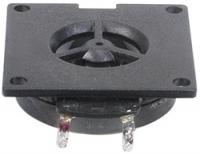
Power Handling: 20 watts RMS/40 watts max
VCdia: 3/8″
Znom: 4 ohms
Re: 3.50 ohms
Frequency range: 6,000-20,000 Hz
Fs: 4,200 Hz
SPL: 87 dB 2.83V/1m
It wasn’t until very recently that I found a bargain on woofers to make these speakers a reality. Made by Hi-Vi Research, these 3″ shielded mid/woofers have a square frame which makes them easier to mount in an array.
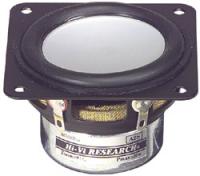
Power Handling: 15 watts rms / 30 watts peak
Znom: 6 ohm
VCdia: 3/4″
Re: 5.2 ohms
Frequency range: 85-9000 Hz
SPL: 82db 1w/1m
Vas: 0.05 cu ft
Qms: 4.68
Qes: 0.43
Qts: 0.39
Fs: 85 hz
Xmax: 2.85mm
So here is the plan: 80 inches tall with 30 tweeters and 20 woofers in each speaker for a total of 100 drivers, each channel a mirror image of the other. The tweeters would have to be back-mounted, so a 3/4″ round-over makes for a nice pseudo-horn effect. The backs are to be open and the speakers equalized to flat response in the actual listening environment.
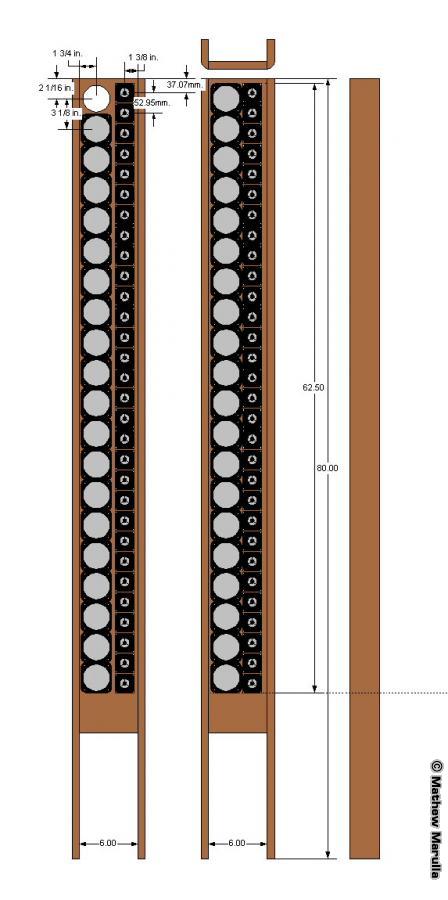
Line Source Plan
The early construction was nothing but lots and lots and lots of drilling. Sorry, no pics of that joy. First, mounting the tweeters.
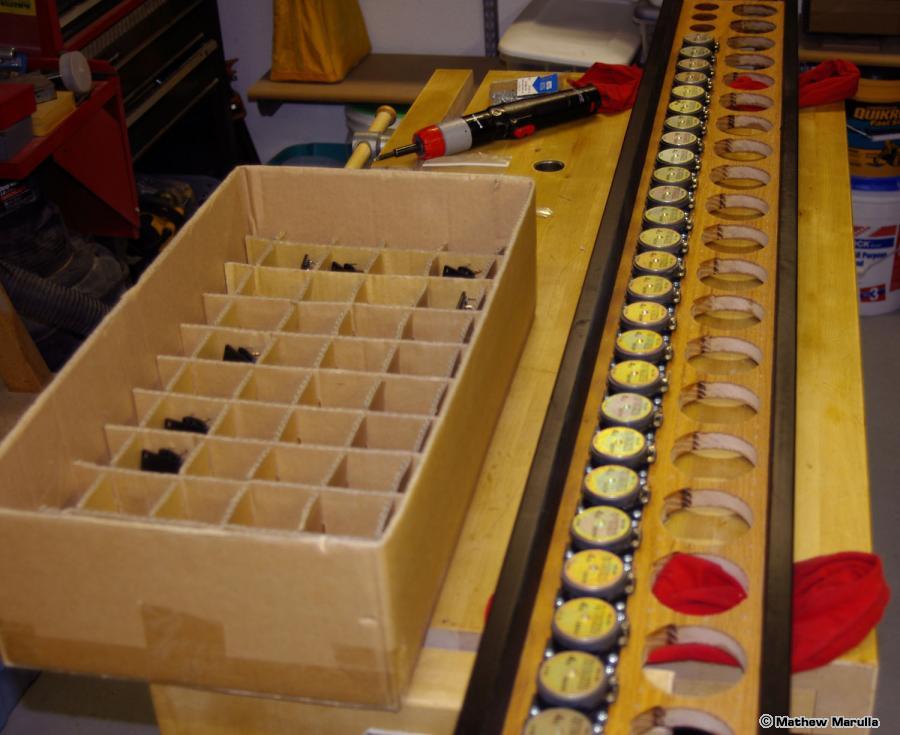
Mounting the Tweeters
Then, getting the woofers unpacked and ready for install.
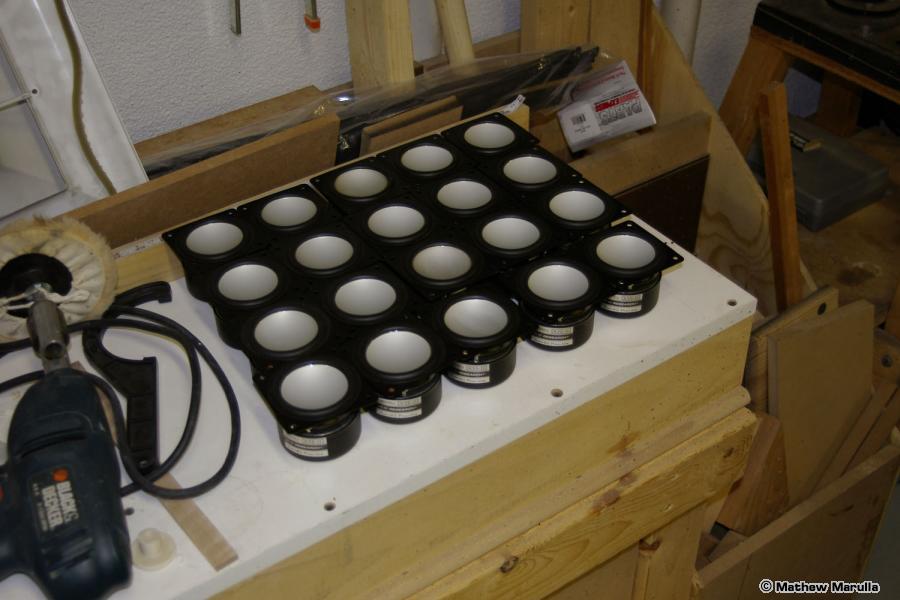
Woofers Ready for Mounting
The holes for the woofers were pretty tight, not leaving a lot of wiggle room to get all the spacing exact. By darkening the space between the woofers with a magic marker, a little misalignment goes unnoticed. You can see a nice detail of the rounded-over tweeter holes here too.
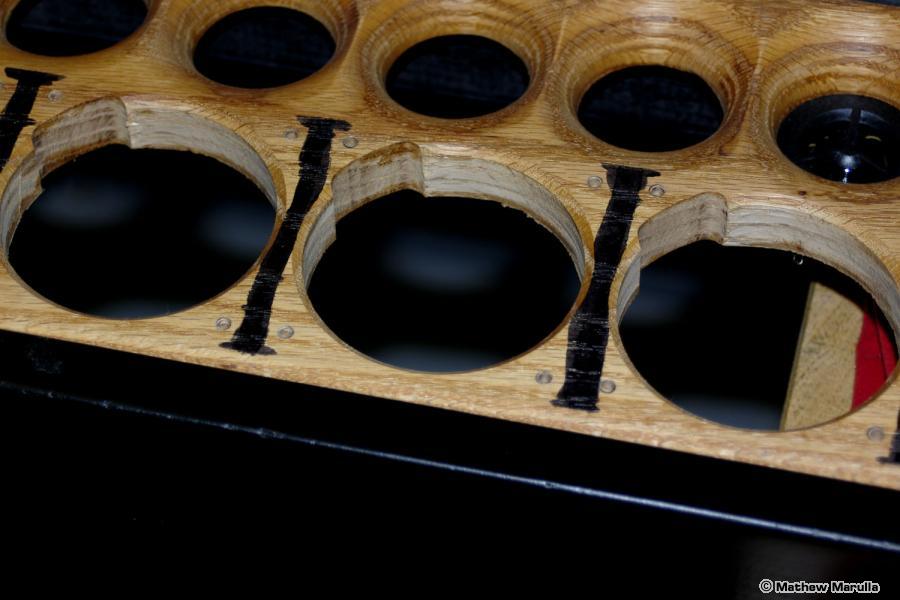
Darkening the Intra-Woofer Spaces
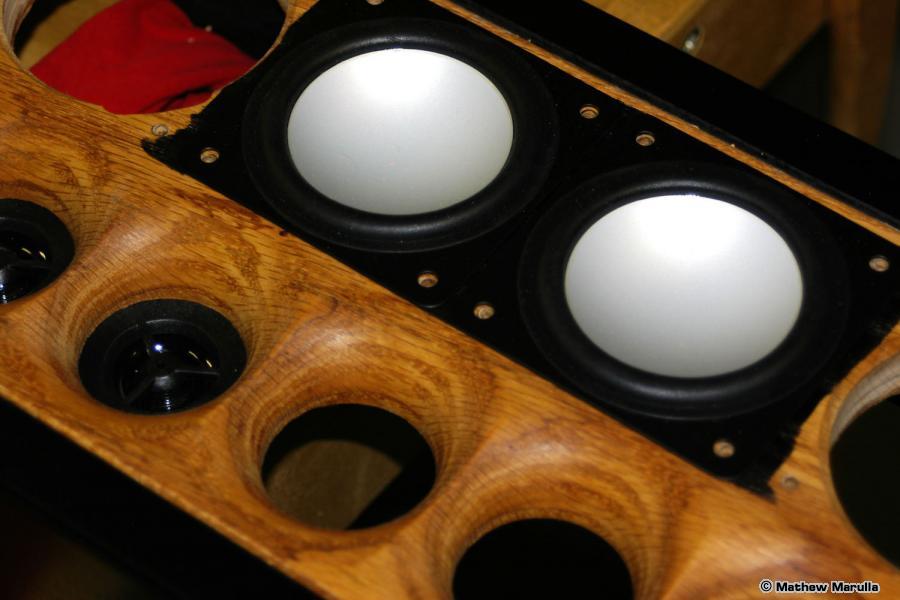
A Handy Cheat!
Mounting the woofers. The terminals do not fully clear the woofer holes, so I had to do “wire-as-you-go” while installing the woofers.
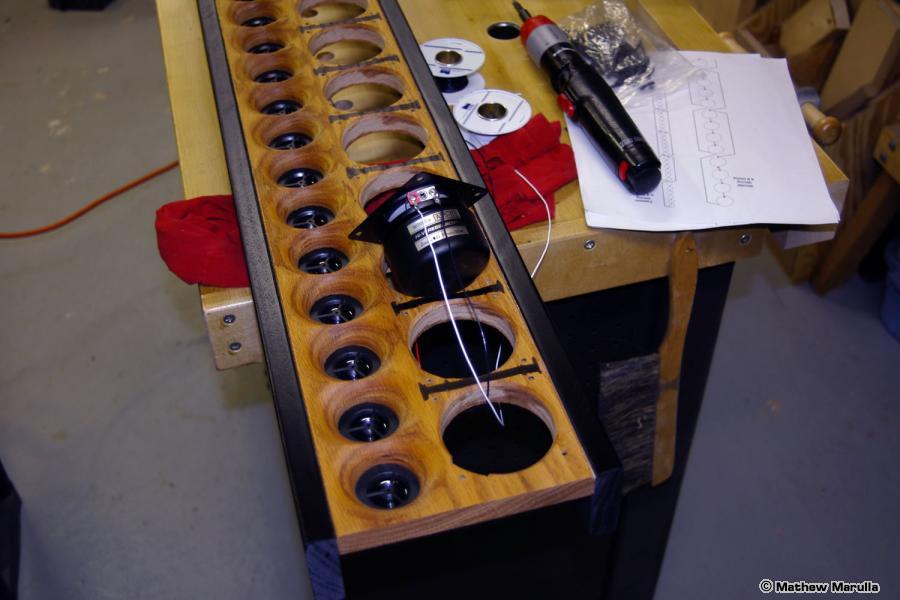
Mounting the Woofers
Everything finally mounted and wired. That’s only 100 driver holes, 400 mounting holes, and 200 soldered connections!
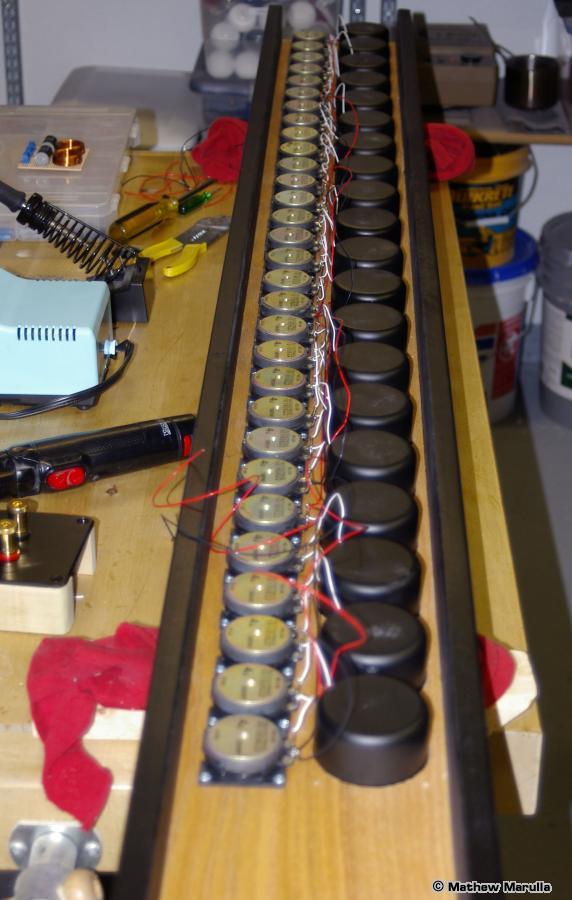
Everything Mounted and Wired
Here’s a shot of the crossover network (24db at 7500Hz), and the terminal panel.
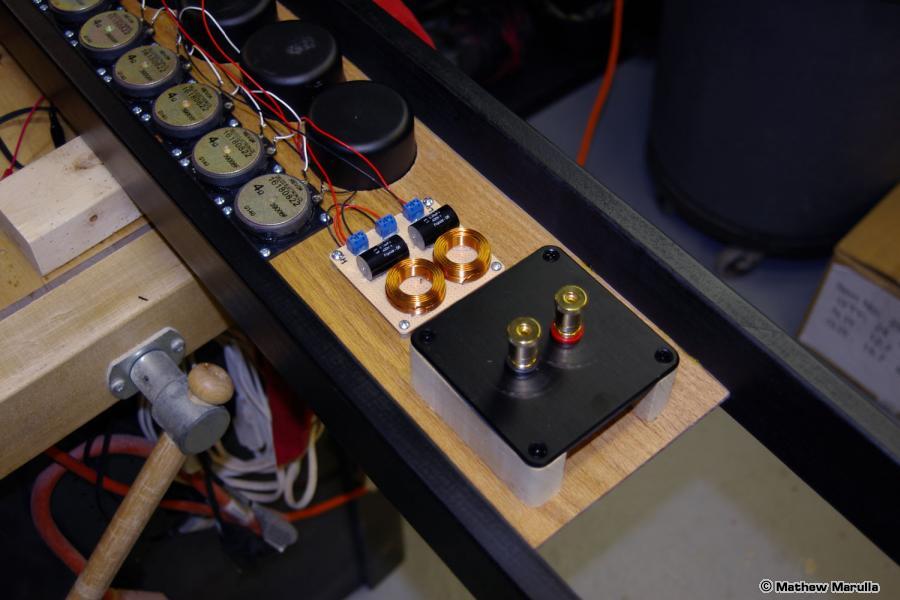
Crossover and Terminals
The base took some special consideration. After everything was mounted, I was surprised at the weight. I guess 50 drivers add up! Also, since they were over six feet tall, I needed to make sure that tipping would be a non-issue. So I used a pair of machine screws and dowel nuts per leg, and an oversize base.
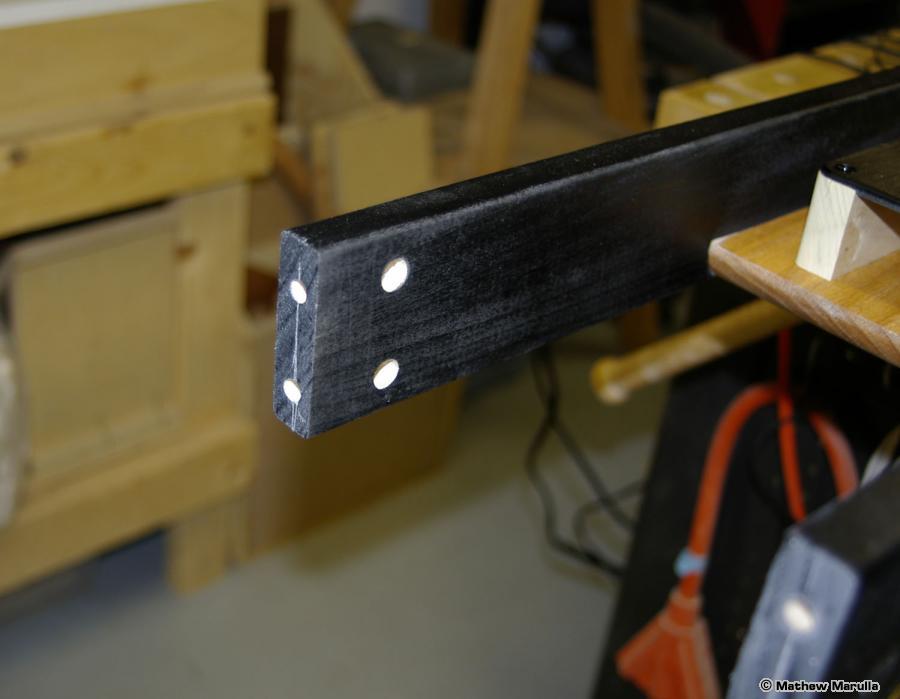
Holes for Dowel Nuts
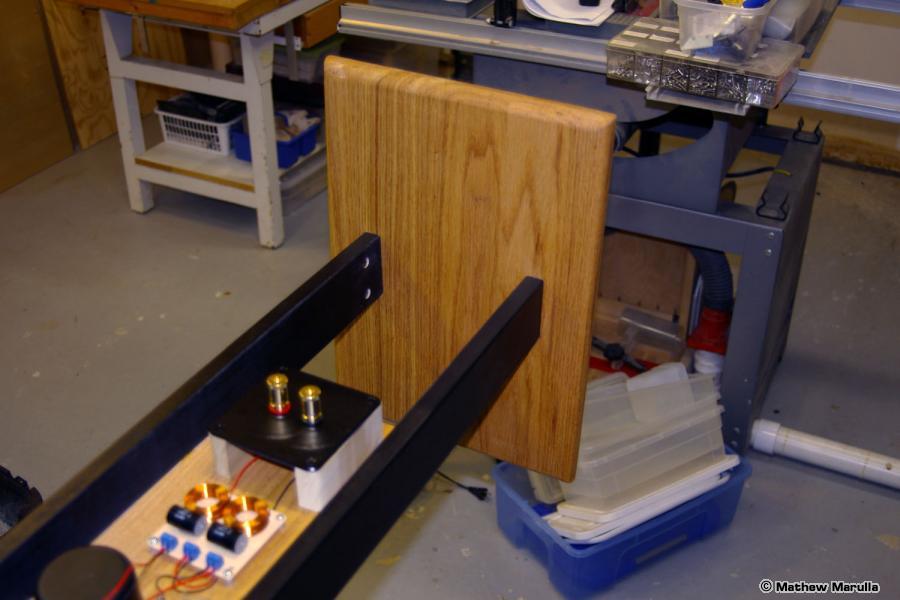
Base Attached
And that’s all, folks!
The sound was a little nasal at first, but I expected some equalization would be required. First a bass boost because the woofers, at 3″, were never designed to go very low. However, 20 of them together have almost as much area as a 15″ woofer. Handling the power of such a boost is easy since the input power is split 20 ways. Second, there was a little bump around the crossover point to tame. And finally, the tweeters were not exactly flat from the factory.
I used a pair of mono 1/3 octave equalizers from Audio Control, a TrueRTA spectrum analyzer and a Behringer calibrated microphone a to get things pretty flat, but after a few hours use it wandered from that goal by quite a bit. I let the drivers break in for about 200 hours and then re-equalized.
After getting dialed in, the sound is pretty amazing. Here are the finished speakers in my listening room.
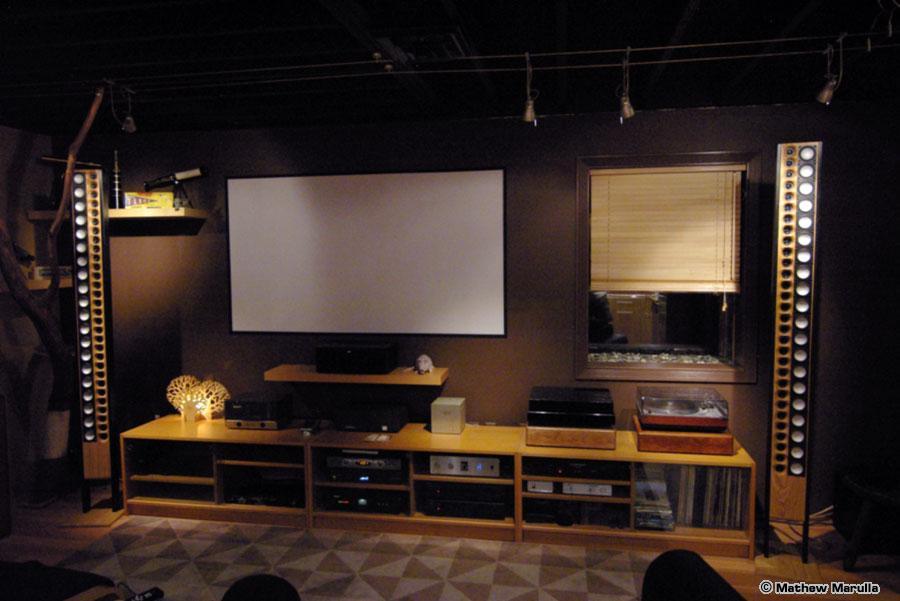
Line Source Speakers in Place
Nice work!
Unfortunately my line arrays are still in the box (20 pcs of TB’s)
Your speakers system looks very cool. It’s funny how a project like yours can add up the dollars fast (line source speakers). I did a line source system based on the Infinity Irs Beta. I bought some Infinity Beta (stressed) woofer towers and reworked them and manufactured the mid /hf panels. I bought almost all my stuff from PE. Just thought that I would comment. If you would be interested send me an email and I will shoot some photos your way.
Pete
your speakers system looks very cool
man those look BA, if nothing else its one hell of a conversation starter.
fits well with the studio style appt layout.
Hi Matt, Can a novice (sort of) handle this project? How are the speakers wired? In a combination of series/parallel networks?? Please explain or send a sketch/diagram.
Thanks, Wayne
Wayne –
The hardest part is drilling all the holes, and that just takes patience.
As far as the wiring, I lucked out on the driver impedances…
The woofers are 6 ohms each, so I wired four in series to make a 24 ohm group and then wired the groups in parallel. 20 woofers makes five groups in parallel for a total of 4.8 ohms.
The tweeters are 4 ohms each, so I wired six in series to make a 24 ohm group and then again wired the groups in parallel. 30 tweeters makes five groups in parallel for a total of 4.8 ohms.
So the crossover sees about the same impedance from both the woofer array and the tweeter array. I noticed that the specs on the Parts Express page list the tweeter impedance as 6 ohms now, but all the other specs are identical. I’m guessing they are the same, just listed differently. Impedance varies wildly with frequency, so listing a single number is pretty much just manufacturer’s opinion anyway.
Hey there! Very good work.
For what it’s worth, those Onkyos are on even deeper sale for $10 for a box of 200, right now.
I’ve never built a speaker, but have been mildly interested for years, and at that price, even if I sold some off to friends for ten cents a pair, it was hard to turn down. 😀
http://www.parts-express.com/pe/pshowdetl.cfm?&Partnumber=269-810
that is just plain old badass man, nice job matt!
Matt,
These are wonderful and are very well built. Please can you email me the wiring diagrams that you designed. I want to make the same line array using a tube. Please email thanks and keep up the great work!!!
Aaron
Aaron –
Just posted the wiring diagrams. http://www.marulla.com/audio/line-source-speaker-wiring/
The frames for the speakers should be braced with some sort of angled support. Then these should sit on spikes into your floor. Maybe you’ve done that.
Not sure what kind of speaker wiring you used but it looks like thread. After all that soldering I don’t imagine you’re in the mood to change it but next time choose that wire carefully so it matches whatever is linking the speaker terminals to your power amp terminals. It doesn’t have to be crazy expensive. This looks like 18 gauge lamp cord.
I’m sure the first question in most reader’s minds is how low do these midrange drivers go when so many are used? You must know as you were dialing in their response curves.
Try not to use equalizers. They almost always degrade the sound. Rather try to tame problems with the speaker crossover components and especially room treatment. If you have to use equalizers try parametric ones. if you’re ever playing digital sources maybe you can equalize them on your computer with software. A good D/A converter is crucial.
You are using an open baffle design. Kudos as most people would never dare. This also makes us all the more curious about low a frequency response you’re getting as its always more challenging without a box. If you ever get a chance to borrow a really fast subwoofer with servo control you may be amazed at the results. Also your speakers may do better if they’re not struggling with frequencies below about 100 hz.
Because its open baffle/boxless, did you consider trying side baffles to reduce the impact of the rear wave?
Your setup: These look like they are about 3′ from the back wall which is ludicrous when it comes to dipole speakers. Its actually ludicrous even with box speakers. If you want pinpoint imaging and a spacious, natural sounding soundstage you cannot be anywhere near the back wall. 6′ minimum, but really it should be more like 10′. Also the back wall needs to be treated. Being that they are so close to the wall the stuff on your wall is going to mess things up even more as its not symmetrical left to right. Bring those speakers out, way out, for a very different acoustic experience.
Your TV is not in between the speakers……What? Sorry – I’m a little OCD when it comes to symmetry. But you have to admit this is a little odd.
In another comment I mentioned bringing the speakers forward. Look at how close the right speaker is to one of your turntables. That can’t be good. Bringing them forward will help that.
Not being centered on the TV is fine – these are for stereo music only. I have a separate 7.1 system for home theatre.